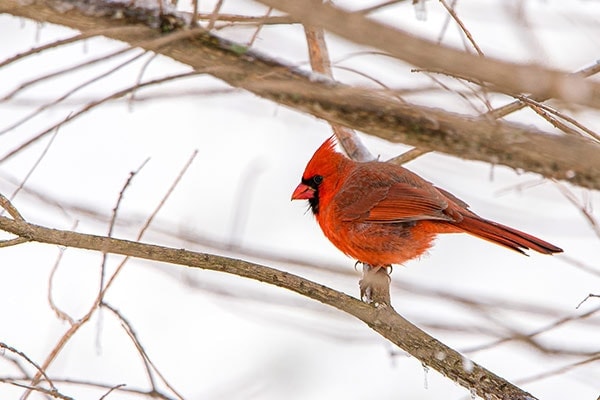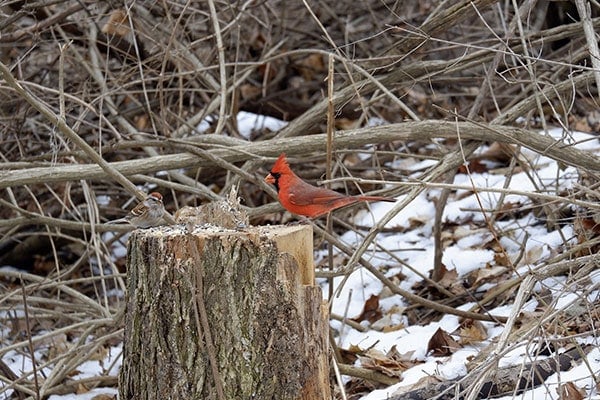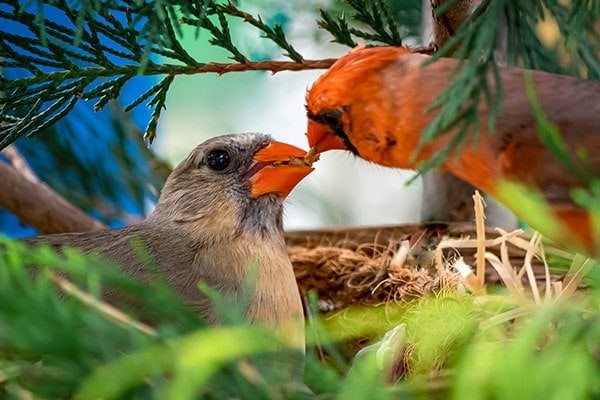Whether you’re a first-time birdwatcher or a long-time enthusiast, cardinals are a wonderful addition to any backyard, and the first time you see their fantastic red plumage contrasting with the white snow you’ll be hooked. So, why don’t they migrate?
I’ve always loved cardinals and have done extensive research on them and their nesting, eating, and behavioral habits. The biggest reason cardinals don’t migrate is they prefer to live within a one square mile area of where they were born.
That’s right.
They live their entire lives within one square mile of where they were born.

Would you like to learn more? How about…
WHERE Cardinals like to live…
WHY they don’t like to migrate…
And,
HOW they survive in the winters.
Read on to find out…
- Why cardinals don’t migrate
- Why are they so territorial
- How they team up for sustenance
- Cardinal winter survival guide FAQs
So lets dive into finding out “why do cardinals come out in the snow?“
Year-Round Red Feathered Neighbors
If you’re like me, the winter months can seem to drag on forever, most of my birds traveling south for the winter, but not my cardinals. I love watching them feed in the snowy months, their red markings so distinctive against the white snowfall. They are hearty little friends, feeding outside while I’m inside with a cup of coffee and a fire at my side. Well, okay so maybe that’s an imagined fire but you get the point.

So why do they stay? Why do they tough it out through those cold winter months when so many other birds leave for warmer climates?
Well, it isn’t the cold.
Trust me. It’s not.
It might be hard to believe something so small and delicate looking as a cardinal could be hearty enough to survive the cold winter months, but it’s true. You see, it isn’t about the cold. Believe it or not, the temperatures don’t affect cardinals. As long as the birds have an adequate supply of food, they will remain in place and feed regardless of how cold it gets.
Cardinal Diet
Most birds who have a steady diet of insects and fruit simply have to give it up during the winter months because of the scarcity of their food supply. There isn’t a ready supply of insects in winter nor fruit. They have to fly south to find those supplies in warmer climates where those kinds of foods will be in ready supply. Believe it or not, some birds from North American migrate from as far north as Canada to South America. Crazy, but true!

Well, thankfully, cardinals are kind of the garbage disposal of the bird world. A typical cardinal diet consists of 30% insects and 70% fruits, grains, seeds, and different kinds of greens.
As you can see, they eat a little bit of everything:
- Insects
- Fruits
- Greens
- Seeds
- Other Foods
Because of this, cardinals can usually find plenty of other foods because they live in suburban settings, woodlands, swampy areas, and farmlands. This means they have access to a variety of seeds.
The different kind of seeds they enjoy are:
- Sunflower seeds
- Safflower seeds,
- Squash seeds
- Black oil sunflower seeds
- Boxelder seeds
- Ragweed
This should make you stay on top of filling the feeders for your cardinals so they’ll stick it out through the winter with you. You can set out different fruit slices too. They enjoy the same fruits we do. They’ll eat apples, raisins, strawberries, cherries, blackberries, and grapes. It can be fresh or dried as in a mix.
They will also eat just about anything that falls on the ground. Cracked corn, bread crumbs, and even maple sap from holes left in trees.
Now, if you drop the ball and there is a limited food supply, they will seek food elsewhere further away from their ‘home base’ area.
So, how big is this ‘home base’ area?
Being Territorial
Most cardinal pairs are fierce when it comes to guarding their territory which is typically a total of 3 to 10 acres in size. The size of their claimed territory will largely depend upon the availability of food supplies.
For cardinal pairs, who have defended their claimed territory time and time again against other cardinal pairs looking to infiltrate their home territory, why would they migrate only to have to come back and fight for it once again? As hard as cardinal pairs work together to build nests and protect their brood from predators, they don’t like to waste energy by fighting for something they honestly don’t need to.
Because cardinals are so fierce, pairs would rather deal with the cold than give up their territory. Other cardinals might hone in on their great location and reap the benefits of a steady food supply. That’s simply too good to give up.
Even though they never return to the same nest twice and always build a new one, they don’t want
Setting Aside Differences by Forming Gangs
Yeah, bet that title got your attention, didn’t it?
Well,
believe it or not,
cardinals do group together.
Not so much in gangs but in flocks. This is particularly true in the fall and the early winter months. They will group each day and wander around large areas in search of food for the entire flock. Interestingly enough, these flocks tend to be equal parts male and female. It’s almost like the pairs have each other’s backs while participating in the flocks.
The flocks also tend to roost together at night, watching out for each other. With the flocking behavior, cardinal pairs are sometimes drawn away from their original nesting area. They will continue to stay together searching for backyards with sunflower seeds. Cardinal flocks typically feed late in the day during what is called the golden hour because of how the sunlight makes their plumage seem to glow.
Sadly, the winter cardinal flocks don’t last all year long. They typically disband by early spring but in most cases late winter. Once that happens, each of the pairs leaves to stake claim to their breeding grounds, and clusters of cardinals descending on your backyard will immediately start to decrease.
Cardinal Winter Survival Guide FAQs
Can I Overfeed Cardinals in the Wintertime?
While yes, cardinals can and will enjoy one of the widest variety diets, and eat just about anything you can throw at them, they will not overeat. They aren’t like goldfish. So, feel free to set out your fresh fruit, seed, and other tasty morsels for the hordes of cardinals that will descend upon your backyard over the winter months.
Is It Better to Set Out Seed or Fruits?
Honestly, your cardinal flock will not care whether it’s fresh fruit, seeds, or a housefly you swatted. They’ll eat it all. Remember, they are the raccoons of the bird world and will eat practically anything.
Keeping Other Birds Away From Your Cardinals?
Thankfully during the winter months, this won’t be a problem. As other birds are migrating, you can help your cardinal family hold onto their territory by feeding them and keeping them with ample food supplies for the winter.
Closing Thoughts On Why Cardinals Come Out in the Snow
Cardinals are always one of the big draws for home birdwatchers. With the male’s bright red plumage and the female’s red highlights and tan plumage, they make quite the entrance to any snow-covered backyard. With such wonderful contrasting colors, they can help brighten the winter months and make the days not so long.
Not affected by the cold they will gladly keep you company over the winter as long as you take care of them by keeping your feeder full. They’ll have no reason to leave, offering you beautiful sights day after day as they feed.
Help keep their home territory safe so they won’t have to fight for it come springtime by keeping them in their home base by not having them have to work so hard to find sustenance during those winter months. Help your cardinal family make it through the winter and they’ll help you in return. Feed them. Enjoy them. Love them.
The post Have You Ever Wondered Why Cardinals Like To Come Out In The Snow? appeared first on BirdInformer.com.
from BirdInformer.com https://ift.tt/3tp1Uwj

No comments:
Post a Comment